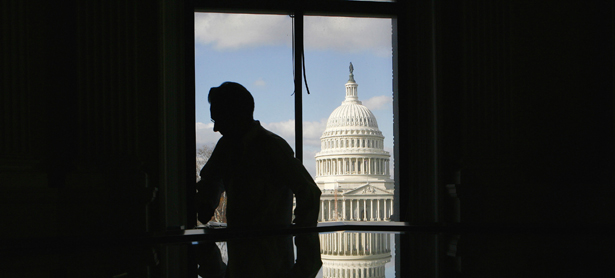
Reuters/Jim Young
For years, congressional staffers have been cashing in their government experience for more lucrative positions lobbying in the private sector. But as Lee Fang reports, another dynamic is increasingly playing out in DC: Lobbyists from the defense, medical and financial industries are now taking up top government positions—but not without receiving large bonus payments from their former firms to see them on their way. Here are five lobbyists-turned-congressional staffers who have made use of this reverse revolving door:
 Before he became one of Speaker John Boehner’s closest aides, Brett Loper led efforts to block the Affordable Care Act medical device tax as the director of government affairs for the Advanced Medical Technology Association (AdvaMed), a trade association for medical device companies, including Baxter International and Medtronic. As Loper took his congressional job in January of 2011, he filed an ethics form that showed that AdvaMed paid him $100,147 in bonus. Forms filed with the IRS show that AdvaMed had already paid Loper a $72,500 bonus in addition to the $466,366 in compensation he earned for the year ending December 31, 2010. The ethics form filed by Loper states he earned only $449,661 from his AdvaMed position the year he began work in Congress. Neither Loper nor AdvaMed responded to requests for comment about this apparent discrepancy.
Before he became one of Speaker John Boehner’s closest aides, Brett Loper led efforts to block the Affordable Care Act medical device tax as the director of government affairs for the Advanced Medical Technology Association (AdvaMed), a trade association for medical device companies, including Baxter International and Medtronic. As Loper took his congressional job in January of 2011, he filed an ethics form that showed that AdvaMed paid him $100,147 in bonus. Forms filed with the IRS show that AdvaMed had already paid Loper a $72,500 bonus in addition to the $466,366 in compensation he earned for the year ending December 31, 2010. The ethics form filed by Loper states he earned only $449,661 from his AdvaMed position the year he began work in Congress. Neither Loper nor AdvaMed responded to requests for comment about this apparent discrepancy.
Image courtesy YouTube.
 In January, when Senator Jim Inhofe (R-OK) became the ranking member of the US Senate Armed Services Committee, he hired Ambrose (Bruce) Hock, a Northrop Grumman executive and former lobbyist for the company. Northrop Grumman paid Hock, now a senior staffer with Senate Armed Services, up to $450,000 in bonuses and "long term incentive pay" in March.
In January, when Senator Jim Inhofe (R-OK) became the ranking member of the US Senate Armed Services Committee, he hired Ambrose (Bruce) Hock, a Northrop Grumman executive and former lobbyist for the company. Northrop Grumman paid Hock, now a senior staffer with Senate Armed Services, up to $450,000 in bonuses and "long term incentive pay" in March.
Image courtesy Linkedin.
 In 2011, shortly after assuming the chairmanship of the House Armed Services Committee, Representative Buck McKeon (R-CA) hired Tom MacKenzie, a Northrop Grumman executive and former lobbyist for the company, to help oversee the committee. Financial disclosures show MacKenzie was paid a "severance and bonus" of $498,334 from Northrop Grumman, just before he was hired to work in Congress.
In 2011, shortly after assuming the chairmanship of the House Armed Services Committee, Representative Buck McKeon (R-CA) hired Tom MacKenzie, a Northrop Grumman executive and former lobbyist for the company, to help oversee the committee. Financial disclosures show MacKenzie was paid a "severance and bonus" of $498,334 from Northrop Grumman, just before he was hired to work in Congress.
Image courtesy: Northrop Grumman.
 David Krone left his senior lobbying position with Comcast to become Senator Harry Reid's (D-NV) chief of staff in 2011. In an arrangement The Wall Street Journal described as “unusual,” Comcast paid Krone over $2.9 million dollars in severance and salary, in addition to $1.2 million for the purchase of his Philadelphia condo, which Comcast later sold at a loss.
David Krone left his senior lobbying position with Comcast to become Senator Harry Reid's (D-NV) chief of staff in 2011. In an arrangement The Wall Street Journal described as “unusual,” Comcast paid Krone over $2.9 million dollars in severance and salary, in addition to $1.2 million for the purchase of his Philadelphia condo, which Comcast later sold at a loss.
Image courtesy: Milken Institute.
 Dwight Fettig left his job lobbying for JPMorgan Chase, the American Bankers Association and others in December of 2010 to become the Staff Director of the US Senate Banking Committee under Senator Tim Johnson (D-SD). He received "Salary + Bonus" of $448,225 as he left the private sector to enter government. Fettig left Congress in December of 2012 to return to K Street as a bank lobbyist, earning up to $400,000 a year.
Dwight Fettig left his job lobbying for JPMorgan Chase, the American Bankers Association and others in December of 2010 to become the Staff Director of the US Senate Banking Committee under Senator Tim Johnson (D-SD). He received "Salary + Bonus" of $448,225 as he left the private sector to enter government. Fettig left Congress in December of 2012 to return to K Street as a bank lobbyist, earning up to $400,000 a year.
Image courtesy: Porterfield, Lowenthal and Fettig.
For more on these lobbyists-turned-congressional staffers, read Lee Fang's new article, The Reverse Revolving Door: How Corporate Insiders Are Rewarded Upon Leaving Firms For Congress.


